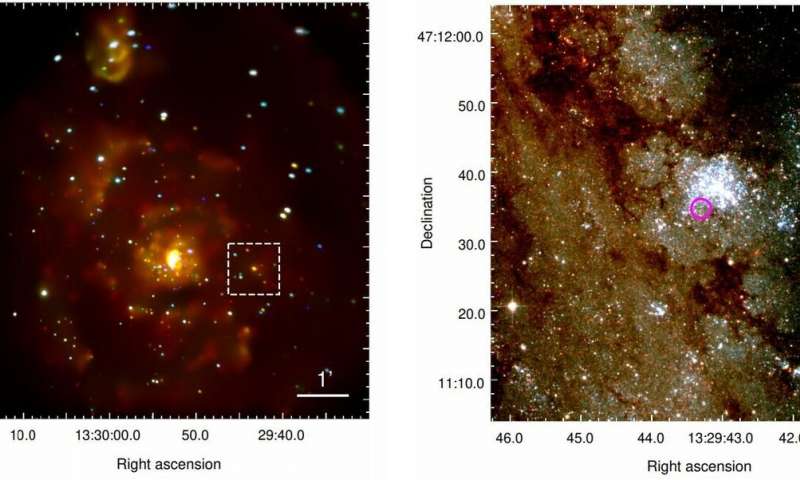HOME
First candidate for an extragalactic planet identified

Left: false RGB stacked Chandra/ACIS-S image of the Whirlpool Galaxy, M 51 (total exposure of ≈850 ks). Colored points are XRSs: Red is 0.3-1 keV; green is 1-2 keV; blue is 2-7 keV. M 51-ULS1 is the orange source at the center of the 60'' × 60'' dashed white box. Diffuse emission is from hot gas. Right: HST image of the area defined by the white box in the top image. Red is the F814W band; green is F555W; blue is F435W. The magenta circle marks the X-ray position of M 51-ULS, which lies at the edge of a young star cluster. The source is located at right ascension and declination 13:29:43.30, +47:11:34.7, respectively. Credit: arXiv:2009.08987 [astro-ph.HE]
A team of researchers from the U.S. and China has found the first evidence for a candidate planet in another galaxy. In their paper uploaded to the arXiv preprint server, the team describes their work studying the possible planet and what they have found so far.
Space scientists have found evidence of many planets beyond our solar system; exoplanet discoveries now number in the thousands. But so far, all exoplanets have been discovered within the Milky Way galaxy. These discoveries have led scientists to believe that there are likely billions of planets in the Milky Way. But thus far, it has not been possible to identify a planet that exists in another galaxy. In this new effort, the researchers believe they have found such a candidate. If it is confirmed, it will be named M51-ULS-1b. The planet candidate lies in the M51 Whirlpool Galaxy and is approximately 23 million light years away. M51 lies relatively close to Ursa Major.
In most cases, identifying a planet at such a distance would be extremely difficult, if not impossible. But in this case, the work was made easier due to a host of unique candidate attributes. First, the object lies within a binary system that has either a black hole or neutron star at its center, which happens to be in the process of consuming another star. In so doing, it is emitting a huge X-ray signal, which caught the attention of the researchers. Such sources are rare in the night sky. Another factor in the discovery was that the source of the X-rays has proven to be very small—so small that an object passing between it and researchers here on Earth would temporarily block the X-rays. And that is what the researchers observed—a possible planetary transit that lasted for approximately three hours.
News Source